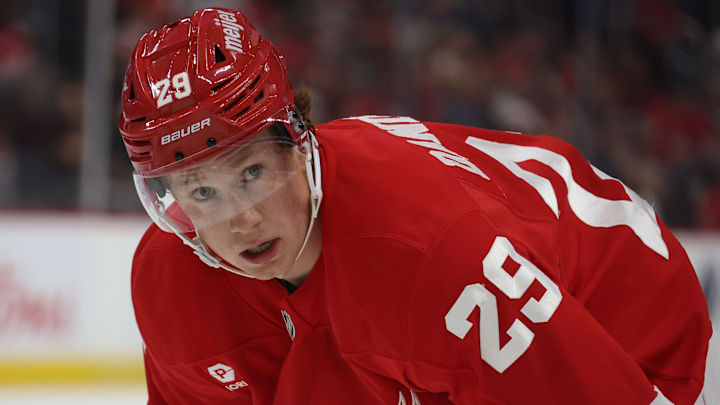Over the past decade, the Detroit Red Wings have pursued a deliberate strategy of replenishing their organizational core, amassing a prospect pool rich in both skill and potential. From the poised, puck-moving precision of defenseman Axel Sandin-Pellikka to the dynamic offensive instincts of forward Marco Kasper, the franchise’s developmental pipeline reflects a calculated investment in its long-term resurgence—though one not without the exasperations of its protracted rebuild. Yet, as the 2025–26 season approaches, no emerging talent commands greater attention, or embodies that vision more fully, than center Nate Danielson.
At just 20 years of age, Danielson is more than a precocious talent—he is the embodiment of a complete, 200-foot center. Standing 6-foot-2, he blends elite acceleration, acute hockey intelligence, and a measured equanimity that belies his age. When he steps onto NHL ice for the first time, that composure will be indispensable in neutralizing top opposition lines and prevailing in pivotal faceoffs. What renders Danielson particularly formidable is that his excellence is almost understated; he does not rely on ostentatious displays of skill, but rather on an unrelenting mastery of fundamentals. He scores, orchestrates plays, extinguishes power plays, avoids infractions, and sustains high-tempo shifts without visible fatigue. In short, he is a consummate workhorse—one whose endurance and consistency promise to define his career.
A Born Leader
Before entering the Red Wings’ developmental pipeline, Danielson distinguished himself as captain of the WHL’s Brandon Wheat Kings, where his final season offered a masterclass in two-way proficiency. He recorded 33 goals and 45 assists for 78 points in 68 games—an output that not only affirmed his status as a point-per-game producer but also underscored his capacity to dominate at both ends of the ice. While junior statistics are not a perfect analogue to NHL performance, it is noteworthy that many eventual professionals never approach such production at that level. His totals, in fact, represented the Wheat Kings’ highest single-season point total in over seven years, cementing his place in the club’s recent history. His leadership translated well to his next team.
Midway through the season, Danielson was traded to the Portland Winterhawks—a shift that can easily disrupt a player’s equilibrium. Some view such moves as affronts, others as catalysts; in Danielson’s case, his methodology remained so unwavering that any emotional tremor was imperceptible. What was readily apparent, however, was the steady ascent of his play. In the WHL playoffs, he became the Cold Stone Creamery of Portland’s offensive architecture, a veritable engine of beautiful creations, orchestrating 13 assists in 11 games while continuing to assert his own scoring presence. This duality—combining personal production with the elevation of those around him—drew the attention of Detroit GM Steve Yzerman, the franchise’s iconic former captain who, from 1986 to 2006, led the Red Wings to three Stanley Cup titles. Yzerman has long urged his current NHL veterans to embody more substantive leadership; Danielson, by contrast, appears poised to deliver it instinctively, promising an immediate imprint on both team culture and the fanbase.
The depth of the Red Wings’ prospect pool is such that distinguishing a singular standout can prove challenging. While Simon Edvinsson and Kasper are widely anticipated to evolve into cornerstone contributors for the franchise, Danielson’s versatility and consistent excellence across nearly every facet of the game position him as the unequivocal embodiment of completeness within the system at present. This is not to diminish the exceptional talent of Edvinsson and Kasper—they are, without question, elite—but Danielson possesses a certain indefinable quality that sets him apart. Consider, for example, Cale Makar: a generational talent whose prowess reshapes expectations. Yet this does not diminish the value of players like Bowen Byram, who epitomizes a solid two-way defenseman, combining astute stick positioning, elite skating, and incisive offensive instincts. Byram may not occupy Makar’s stratosphere, but that distinction does not detract from his considerable skill set. Should Edvinsson and Kasper embrace such realities, their complementary strengths will only enhance Detroit’s collective potential. In unison, this convergence of talents augurs well for the franchise’s aspirations of mounting a substantive playoff run in the near future.
Danielson embodies precisely the caliber of player that the franchise’s leadership has long sought throughout this protracted rebuild. As the 2025–26 season approaches, he is poised to make his NHL debut, a milestone that could mark the commencement of a significant chapter in his career. Should his trajectory of continuous growth persist, the designation of “best prospect” will soon give way to a more exalted status—one befitting a bona fide cornerstone and future superstar of the team.
More from Octopus Thrower:
